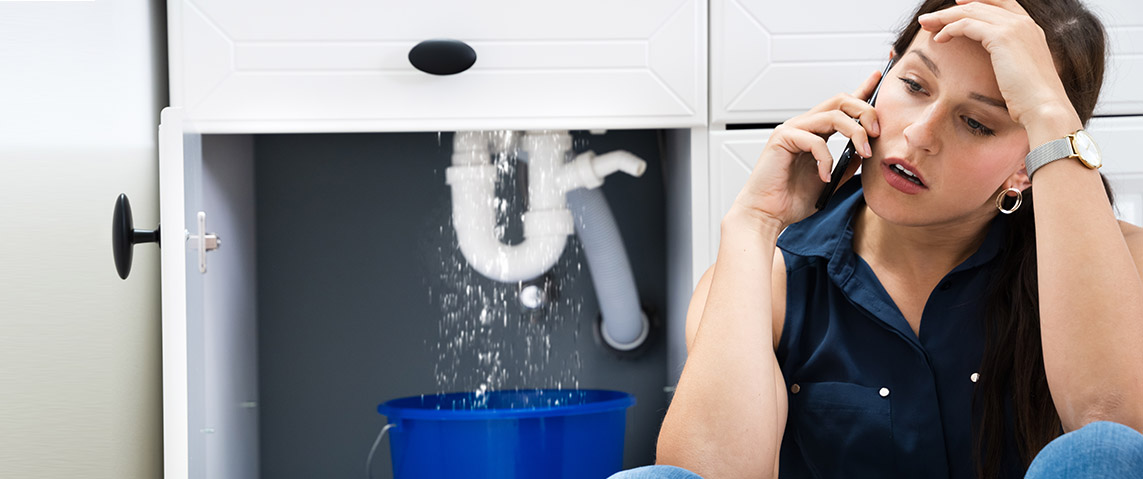Overflow Pipe Leaking? How to fix it | Here's what to do

In this post, we'll cover
What is an overflow pipe?
An overflow pipe extends from the water storage tank to prevent water from leaking into the house area/rooms. The overflow pipe is the most important feature in your home's plumbing system. Overflow Pipe Leaking happens when the tank or cistern fills up to a level more than it should, causing the excess water to flow down into the overflow pipe.
Some common components that have an overflow pipe in your home are:
- Toilet Cistern
- Cold water feed and expansion tank
- Central heating feed and expansion tank
- Copper cylinder
- Combination boiler
- Sinks, basins, and bathtubs
The toilet cistern, Cold water feed and expansion tank, Central heating feed and expansion tank, and the combination boilers overflow outside. The expansion pipe on the copper cylinder flows down into the cold water feed and expansion tank, and the one on the basin and bath flows into the draining sink.
Why is the overflow pipe leaking?
One of the most common reasons that might cause overflow pipe leaking is a problem with a float valve. The float valve is a device that controls the water level; it consists of a plastic/metal arm along with a plastic ball at the end of the arm that floats in the water. Float valves are found in toilet cisterns, expansion tanks, cold water tanks, and central heating feed.
This float valve keeps moving up and down along with the water level to switch on and switch off the cold water feed. The extent of the water level in the tank should be an inch below the overflow pipe. If the float valve does not operate correctly, the cold water feed may not be properly switched off, thus causing excess water overflow.
However, it is considered an alarming situation if the overflow pipe leaks- even if it's a very small leak. Continuous water leaks might result in water overflow and you might have to switch off the entire plumbing system. Read below to find our simple step-by-step guide that will help you find where the leak is and what to do if you see the water leaking from an overflow pipe just so that you can quickly deal with the situation:
Identify which cistern/ water tank Is overflowing
If the leaking pipe is seen on the ground or first floor, it might be your bathroom overflow pipe dripping and coming from the toilet cistern. But if it is at the loft level and is protruding out, then water might be coming from the expansion tank and the central heating feed.
Check the float valve & washer
Sometimes, if the water keeps continuously running into the tank, the float valve might get stuck. Check on the float valve, release it if it is seen stuck, and see if it repeats its normal function. Also, check on the ball to see if it's punctured. If you find problems with the float valve and the ball, it needs to be replaced, and if everything is good, but still the water keeps leaking, then the washer might be worn out and needs to be replaced.
Turn off water feed & drain the water
To work, first, you need to stop the flow of new water into the tank and drain it completely.
- Use the isolation valve to turn the water feed off on a toilet cistern.
- Use a flathead screwdriver to turn the screw clockwise and flush the toilet to drain the water.
- At the stopcock, turn off the mains to stop the water feeding into either of the water tanks.
- You could turn on your bathroom taps to drain it.
- See that the water level is below the area you need to work on.
Check water pressure
Leaky pipes are a major effect of increased water pressure. The tube may leak if the pressure exceeds the pipe's pressure handling capacity. In addition, the water valve, which checks the pressure and the flow of water through the overflow pipe, might have loosened due to continuous water flow with increased pressure. Sometimes, the pipe might also face leakage due to damage.
The toilet overflow pipe leaking
The toilet overflow pipe ends outside the house, and if the water flow within the tank or cistern doesn't stop, it will overflow. This can be fixed in multiple ways:
- Check if the float valve is freely moving: There are chances that the float valve might be twisted within the valve chain.
- Regulate the float valve: Control the extent of the float valve by bending the arm or adjusting the screws to shut the water system off.
- Check water pressure: The overflow pipe may leak due to increased pressure in the water flow within the pipe. The water pressure can be checked in the isolation valve and must be closed to manage the flow.
- Replace the float valve or washer: There might be a damaged valve or washer if the water leakage does not stop after the remedial trials. If this is the case, the washer/ valve needs to be replaced.
Cold water feed and expansion tank overflow pipe leaking
This cold water feed and expansion tank overflow pipe extends through the bigger water cistern to your house's exterior. Water flows to the sinks from the tank. In the case of leakage in any of the system's overflow pipes, it is because of the following reasons:
- The tank's water inlet is not turning off.
If you find a constant drip of water inside the water feed tank, try to adjust/ replace the float valve or the washer.
- Water is being pressured back into the outlet pipe.
If the pipes, float valves, and washers seem to work fine, then the sole reason for the leakage is that the water is pushed back towards the leak through the outlet pipe.
Central heating feed and expansion tank overflow
The central heating feed and expansion tank overflow pipe goes from your water tank in your loft to the outside of the house. Water to the central heating system of the house is provided by the feed and if the overflow pipe of the system is leaking, the two possible reasons are:
- The water feed going into the tank is not switching off
As soon as you see constant dripping of water into the tank, ensure that both the float valve is not damaged or worn out. If you find any such issues of damage, then go ahead and replace the float valve/ washer.
- A problem with your hot water cylinder
If you see your cold water feed working fine and your float valve and washer is also undamaged, then the only issue would be with your hot water cylinder.
Boiler overflow pipe leaking
Boilers have a pipe consisting of a pressure relief valve similar to an overflow pipe. Under too much water pressure in the system, this valve releases water. Also, this pipe in the boiler has its end at the outside of your house and prevents any flooding. This valve only flows when there is a severe problem in the system, so if it is seen leaking, it is important to take notice of the issue immediately.
Note: Pressure Valve Pipes and Condense Pipes are two different. Hot water flows through the condensed pipes when the central heating system is turned on.
If your boiler is leaking water from an overflow pipe then there is excess pressure to the system or due to an issue in the pressure valve. In both cases, it is recommended to call in professionals.
How to deal with an overflowing overflow pipe
1. Identify the source of the leak:
* Check the location of the leak and match it to the corresponding tank.
* Look for signs of leakage around the toilet cistern, cold water feed tank, central heating feed tank, or boiler.
2. Turn off the water supply:
* Locate the isolation valve for the leaking tank and turn it clockwise using a flathead screwdriver.
* Alternatively, turn off the main stopcock to cut the water supply to the entire house.
3. Drain the tank:
* Flush the toilet to drain the cistern.
* Open the taps to drain the water from the sinks.
4. Check the float valve and washer:
* Inspect the float valve for any stuck parts or loose connections.
* Check the washer for signs of wear and tear.
* Replace the float valve or washer if necessary.
5. Check water pressure:
* High water pressure can cause leaks in the overflow pipe.
* If the leak persists after checking the float valve and washer, consult a professional plumber to check the water pressure.
6. Overflow from kitchen sink:
* Clogged drains can cause water to overflow from the sink. Unclog the drain to resolve the issue.
7. Call a professional:
* If you are unsure about fixing the leak or if the leak persists after trying the above steps, call a qualified plumber.Plumbing and Drainage Cover
Overflow from kitchen sink
The overflow pipe of the sink is placed just below the sink and has its opening down the drain. This pipe stops your sink from overflowing. Hence, it would be difficult for you to point out if there is an issue with the sink overflow pipe. However, the problems and indications surface with your sinks or baths. But in case you spot any issue with the drain, then the simple solution is to unclog it and allow the sink to drain off.
Get a plumbing and drainage cover
With all the above information, we have kept you covered with every issue that might happen with the water supply pipes and the why's and how's of it. Yet a blocked drain or a burst pipe will likely slow down anyone. So take out Smart Cover's Plumbing and Drainage Cover to keep yourself up from unexpected situations.
Smart Cover's plumbing & drainage insurance scheme includes:
- Emergencies related to the internal drainage system.
- Collapse/ Blockage/ Leak of the external water supply pipe.
Our engineers work around the clock on various household repair emergencies throughout the year. However, a plumbing and drainage breakdown can occur at any time, and we want you to be secure in knowing that you're covered for repair costs. So reach out to Smart Cover's plumbing & drainage insurance, and the solution is just a call away.
Curious about the potential consequences of leaving your plumbing and drains unprotected? Learn about the risks and challenges you might face by not having the necessary coverage in place. Visit our blog on 'What Will Happen If Plumbing and Drains Are Not Covered' to understand the importance of covering your home's vital systems
By following these tips and taking action at the first sign of a problem, you can help prevent overflow pipe leaks and protect your home from water damage.
Discover essential tips and practices to keep your kitchen appliancessafe and in optimal working condition. Learn how to maintain and use your appliances to prevent accidents and extend their lifespan. Explore our guide on keeping kitchen appliances safe for a well-functioning and secure kitchen environment.
Conclusion
Overflow pipes are an important part of your home's plumbing system, as they prevent water from leaking into your house. They are located in a variety of places, including your toilet cistern, cold water feed and expansion tank, central heating feed and expansion tank, copper cylinder, and combination boiler. If you see water leaking from an overflow pipe, it is important to identify the source of the leak and take steps to fix it. This blog post provides information on how to identify and fix leaks in overflow pipes in a variety of locations in your home.

 Appliance
Appliance








